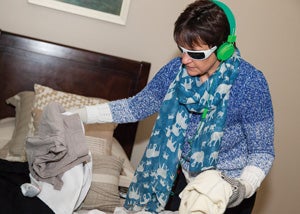Inside Dementia

What’s it like to do the laundry if you suffer from a brain disease like Alzheimer’s?
By Carol McCarthy ’84
With my gait unsteady, I was led down the hall by a confident hand on my arm. I kept blinking as I shuffled along toward a dim apartment, but my side vision remained blurry. When I looked ahead, I saw only black.
My hands were stiff and awkward, and my movements crude, exaggerated. All the while, the noise in my head blared nonstop: A wall of static, competing voices, music, laughter—and suddenly, a siren, which made me jump and blurt out: “Oh God!”
In the apartment, I clumsily sorted through a pile of laundry on the bed, trying to find the white T-shirts so I could fold them and put them in the dresser. With my sight compromised, I tried to go by feel, differentiating the shape and texture of a shirt from a sock. But this was difficult with my crippled hands. I struggled to fold the shirts into anything other than a blob. I walked with deliberation to the dresser and put my messy T-shirts in the drawer.
Relentlessly, the noise rattled my brain, and I came to hate the repeated peals of laughter bouncing around my skull.
Back at the pile of laundry, I dug around for socks, pairing them up uncertainly. I finished my tasks and, mercifully, Jodi DiRaimo—resident engagement director at The Lighthouse at Lincoln, an assisted living facility for people with dementia—slipped the headphones off my ears. I whipped off the glasses and started pulling at the gloves. I had just experienced “A Walk in Their Shoes,” a simulation designed to experience what it is like to live with dementia and to increase awareness and compassion.
The altered sunglasses I wore mimic vision loss from age-related macular degeneration, glaucoma or cataracts, which affect many people with dementia. The knobby pieces of rubber inserted in my shoes simulate corns or neuropathy, and made walking uncomfortable and balance dicey. The textured gloves robbed me of tactile sensation, and the elastic around two fingers on my dominant hand gave my movements the limitations of someone with arthritis. Finally, the headphones blasted a cacophony into my ears, imparting the auditory distortion that a person with advanced dementia often experiences. DiRaimo described it as white noise, but it was so nefarious, I thought of it as black noise.
DiRaimo uses this tool to educate Lighthouse employees and family members, to help train staff members of the Alzheimer’s Association of Rhode Island and other health-care professionals, and to enlighten participants in the Alzheimer’s Association support group she runs.
Researchers with URI’s George & Anne Ryan Institute for Neuroscience are working to tackle the challenges of dementia, of which there are 100 types, and DiRaimo shared the “walk” experience at the URI Brain Fair in March. The Ryan Institute sponsored the event as part of Brain Week Rhode Island, which focused on brain science and brain health.
My “walk” lasted only a matter of minutes but felt much longer. I ended it with perspective, understanding, compassion, and a certain amount of fear and dread.•
 Home
Home Browse
Browse Close
Close Events
Events Maps
Maps Email
Email Brightspace
Brightspace eCampus
eCampus


